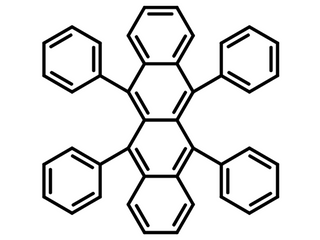Rubrene
CAS Number 517-51-1
Dopant Materials, Materials, OLED Materials, Red Dopant Materials, Semiconducting Molecules, Yellow Dopant MaterialsRubrene, molecular semiconductor with high charge mobility
Applications in organic electronics (OLEDs and OFETs), 5,6,11,12-Tetraphenylnaphthacene, CAS No. 517-51-1, Unsublimed ≥99.0%
Rubrene, a molecule with a tetracene backbone and four appended phenyl rings, is one of the most studied molecular semiconductors due to its high charge mobility. Notably, room-temperature hole mobilities of the order of 20-40 cm2V-1s-1 have been measured for rubrene in single-crystal organic field-effect transistors (SC-OFET) [1]. It is widely used in organic electronics, especially organic light-emitting diodes (OLEDs) and organic field-effect transistors (OFETs).
General Information
| CAS number | 517-51-1 |
|---|---|
| Chemical formula | C42H28 |
| Molecular weight | 532.67 g/mol |
| Absorption | λmax 299 nm (in THF) |
| Fluorescence | λem 553 nm (in THF) |
| HOMO/LUMO | HOMO = -5.4 eV, LUMO = -3.2 eV |
| Synonyms | 5,6,11,12-Tetraphenylnaphthacene |
| Classification / Family | Hydrocarbons, OLEDs, Organic field-effect transistors (OFETs), Organic electronics |
Product Details
| Purity | >99.0% |
|---|---|
| Melting point | 330-335 °C (lit.) |
| Color | Red powder/crystals |
Chemical Structure
Device Structure(s)
| Device structure | ITO/NPB (70 nm)/ADN: 0.5% rubrene (30 nm)/Alq3 (50 nm)/MgAg [6] |
|---|---|
| Color | White |
| Max. Luminance | 11,700 cd/m2 |
| Max. Current Efficiency | 3.7 cd/A |
| Max. Power Efficiency | 1.72 lm W-1 |
| Device structure | ITO/TPD (50 nm)/BePP2 (5 nm)/TPD (4 nm)/BePP2:rubrene (5 nm)/TPD (4 nm)/Alq (10 nm)/Al [7] |
|---|---|
| Color | White |
| Max. Luminance | 20,000 cd/m2 |
| Max. Power Efficiency | 1.11 lm W−1 |
| Device structure | ITO/NPB/CBP:3 wt%TBPe:1 wt% rubrene/Zn(BTZ)2:5 wt% Ir(piq)2(acac)/Zn(BTZ)2/Mg:Ag [8] |
|---|---|
| Color | White |
| Max. EQE | 2.4% |
| Max. Luminance | 23,000 cd/m2 |
| Device structure | ITO/NPB/rubrene in p-DMDPVBi:NPB/TPBi/LiF/Al [9] |
|---|---|
| Color | White |
| Max. Luminance | 18,100 cd/m2 |
| Max. Current Efficiency | 10.6 cd/A |
| Device structure | ITO/PVK:TPD (30 nm)/Zn(BTZ)2:0.05 wt.% rubrene (50 nm)/Al (100 nm) [10] |
|---|---|
| Color | White |
| Max. EQE | 0.63% |
| Max. Luminance | 4,048 cd/m2 |
| Max. Current Efficiency | 4.05 cd/A |
Characterization

MSDS Documentation
Literature and Reviews
- Organic field-effect transistors using single crystals, T. Hasegawa et al., Sci. Technol. Adv. Mater. 10, 024314 (2009), doi:10.1088/1468-6996/10/2/024314.
- Rubrene: The Interplay between Intramolecular and Intermolecular Interactions Determines the Planarization of Its Tetracene Core in the Solid State, C. Sutton et al., J. Am. Chem. Soc., 137, 8775-8782 (2015)
- Luminescence of Rubrene and DCJTB molecules in organic light-emitting devices, C-B. Moon et al., J. Luminescence, 146, 314-320, 2014.
- The effect of rubrene as a dopant on the efficiency and stability of organic thin film electroluminescent devices, Z. Zhang et al., J. Phys. D: Appl. Phys. 31, 32–35 (1998).
- Performance improvement of rubrene-based organic light emitting devices with a mixed single layer, Z. Wang et al., Appl Phys A 100: 1103–1108 (2010), DOI 10.1007/s00339-010-5710-4.
- Efficient and stable single-dopant white OLEDs based on 9,10-bis (2-naphthyl) anthracene, S. Tao et al., J. Luminance, 121(2), 568-572 (2006); doi:10.1016/j.jlumin.2005.12.053.
- Organic white light electroluminescent devices, S. Liu et al., Thin Solid Films, 363, 294-297 (2000); doi:10.1016/S0040-6090(99)01017-2.
- Influence of Dopant Concentration on Electroluminescent Performance of Organic White-Light-Emitting Device with Double-Emissive-Layered Structure, M. Wu et al., Chin. Phys. Lett., 25, 294-297 (2008).
- Co-Host Comprising Hole-Transporting and Blue-Emitting Components for Efficient Fluorescent White OLEDs, Y-C. Chen et al., J. Electrochem. Soc., 159 (4) J127-J131 (2012); doi: 10.1149/2.092204jes.
-
White organic light-emitting devices using Zn(BTZ)2 doped with Rubrene as emitting layer,
J. Zheng et al., Chin. Sci. Bull., 50, 509-513 (2005); DOI: 10.1360/04wb0050.

